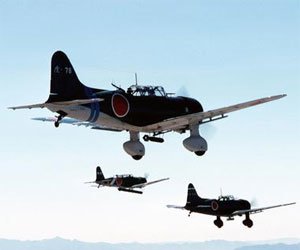Although not a particularly modern-looking aircraft, the Aichi D3A sank more allied shipping than any other Axis aircraft both in its dive-bomber role and its later refit as a kamikaze plane.
In 1936 a contract opened up to replace the obsolete Aichi D1A, a biplane dive-bomber with a more modern craft. Aichi’s D3A won the design contest and went into production shortly after. The D3A was the first all-metal bomber used by the Japanese. It was a low-wing monoplane employing the Mitsubishi Kinsei radial engine. The D3A’s landing gear was not retractable and so a longer dorsal fin was added to increase stability.
The Aichi was typically used as a carrier-based bomber. D3As accompanied the first waves that flew over Pearl Harbour, inflicting heavy damage. In the Indian Ocean, D3A squadrons were known to have sunk the British carrier Hermes along with the cruisers Dorsetshire and Cornwall.
D3As were tremendously accurate in their bombing role with four out of every five bombs striking its target. The D3A remained an integral part of the Japanese navy’s offense up until the 1942 battles of Coral Sea and Midway where many were lost. A year later an aerodynamically improved version of the D3A, the D3A2, entered service but neither model could keep pace with new and numerous American fighters.
Those D3As that were not shot down were put into service as kamikaze planes, a move that sadly may have increased their already impressive accuracy record. A total of 1,495 of these dive-bombers were built.
| Type | Dive-Bomber |
| Power Plant | 1 x 1,080-horsepower |
| Max speed: | 389 km/h ( 242mph) |
| Ceiling: | 9,159 m (30,050 ft.) |
| Range: | 1,561 km (970 mi.) |
| Weight (empty): | 2,409 kg (5,310 lb.) |
| Weight (loaded): | 2,618 kg (5,772 lb.) |
| Wingspan: | 14.38 m ( 47 ft. 2 in.) |
| Length: | 10.24 m ( 33 ft. 7 in.) |
| Height: | 3.32 m (10ft. 11 in.) |
| Armament: | 3 x 7.7mm machine guns; 816 pounds of bombs |
| Service | 1938 -1945 |
